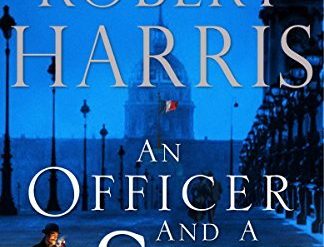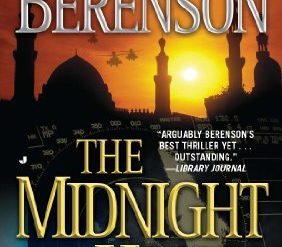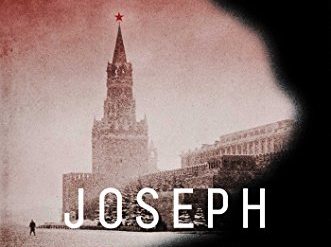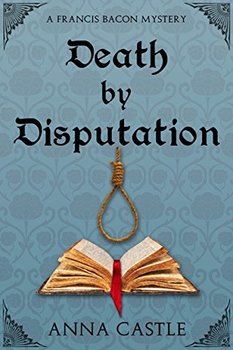
There is no lack of religious conflict in today’s world. Hindus against Muslims. Sunni vs. Shia. Christians and Jews squaring off against Muslims. But it’s hard to find anything today to surpass the sheer complexity of the festering three-way collision of incompatible faiths in sixteenth-century England. Then, barely half a century after Henry VIII pulled the Church of England out of Rome’s orbit, the established Protestant church battled several varieties of more extreme Protestants as well as the remnants of the large and wealthy Catholic population that for so long had ruled over the land. And this contentious scene is the backdrop for the second entry in Anna Castle’s beautifully crafted Francis Bacon mystery series. The novel, a murder mystery that broadens into a suspenseful, high-stakes spy story, revolves around this religious conflict as it plays itself out in the shadow of England’s approaching rendezvous with the Spanish Armada.
Death by Disputation (Francis Bacon #2) by Anna Castle (2014) 360 pages ★★★★★
A cast of characters that fits the history
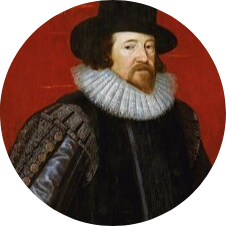
Francis Bacon
In March 1687, when Death by Disputation opens, Francis Bacon (1561-1626) is an aspiring young lawyer at Gray’s Inn in London. He had been the youngest barrister ever to be admitted to the bar, and he continued to show great promise. Later, he would rise to the pinnacle of power under James I. But then Elizabeth I reigned. Bacon worked in the shadow of his powerful uncle, Lord Burghley (1520-98), Elizabeth’s Lord High Treasurer.
Thomas Clarady
Bacon himself plays a major role in the novel, his uncle a minor one. But the focus is on an even younger man, the fictional Thomas Clarady. Clarady is the son of a wealthy ship captain—a pirate, no doubt—and through connections of his own had gained admittance to the prestigious Gray’s Inn to study the law. But, acting on behalf of Lord Burghley, Bacon has pressed Clarady into service as a spy and dispatched him to the University of Cambridge, where agitation by Puritans threatens to disrupt the peace. Clarady’s assignment is to identify the ringleader. But his plans go awry after only “six short weeks as an intelligencer.” A suspect, one of his tutors, turns up dead, a victim of murder.
Christopher Marlowe
Another of Clarady’s tutors, Christopher Marlowe (1564-93), has witnessed the murder. Marlowe, too, would gain great distinction during the few more years of his life. As a poet and playwright and an inspiration for his contemporary, William Shakespeare, he would come to be regarded as one of the leading intellectual lights of the era. But in 1587 he is in his sixth year as a student, just months away from receiving his Master’s degree. And Marlowe is a disreputable sort, widely disliked at Cambridge’s Corpus Christi College.
Clarady doesn’t like or trust him. Marlowe even joins his short list of murder suspects. However, he does respect the man’s talent. “Marlowe was the most brilliant poet Tom—and probably all of Cambridge University and possibly the whole world—had ever known.” In fact, Marlowe may even have already been writing Tamburlaine in 1587, the play that captivated Shakespeare and established his reputation for brilliance.
And several others
Much of the story unfolds in correspondence between Clarady and Bacon, who write to each other on a daily basis. But there are, of course, other characters as well. The headmaster of Corpus Christi, Dr. William Eggerly, and his randy young wife, Margaret, whom Clarady beds every Thursday afternoon. Brothers Steadfast and Diligence Wingfield, Puritans who are students at the college, and their father, Bible-thumping Pastor Wingfield. John Barrow, a popular junior teaching Fellow. And Clarady’s chums at Gray’s Inn, the brilliant Benjamin Whitt and Alan Trumpington, known as Trumpet, son of an earl. Every one of these characters rings true to the times.
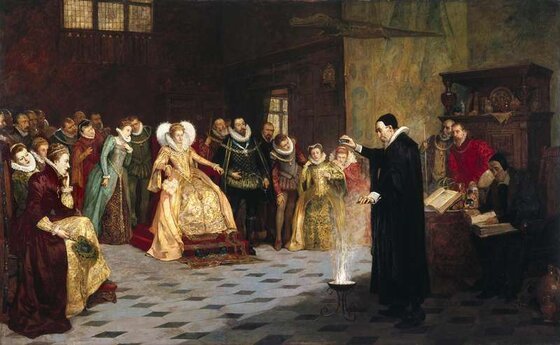
Respecting history
The author’s fidelity to the historical record is exceptional. The details she weaves into her story cast light on life in the Elizabethan Era in ways a reader can almost taste. The food people eat and what they drink. The clothes they wear. The manner of their speech. And the range of concerns that reflect the issues and conditions of the time.
Religious conflict
In 1587, English society was torn apart over religious disputes. Henry VIII’s Church of England held the allegiance of most of the population, but substantial numbers remained faithful to the Church or Rome, and others were flocking to the more extreme Protestant sects. The largest of these were the Calvinists, called Puritans or “precisians” in England at the time, although they thought of themselves as “the godly community.” The name Puritan emerged because of the sect’s professed desire to “purify” the Church and eliminate all traces of Catholicism. And they were anything but subtle about it, as Castle adroitly demonstrates in the novel. Clarady “did not want these fault-finding, fun-hating, hair-splitting Puritans controlling his church or his country.” Which was why Francis Bacon had dispatched him to the college—and why he had interrupted his education at Gray’s Inn to accept the assignment.
In fact, the dangers for England were substantial. As Castle’s story opens, “all of Catholic Europe is in a furious boil over the execution of Mary Stuart last month,” as Lord Burghley tells his nephew. “I have here a letter from a reliable Venetian merchant warning me that King Philip’s armada will sail for either Ireland or England in either June or July. Over two hundred ships carrying more than 36,000 Spanish men-at-arms.” The Spanish fleet was the sixteenth-century equivalent of what Britain’s Royal Navy would later become. Spain was then by far the world’s most powerful military power. And as history records, the Armada did in fact sail for England the following year after delays in port.
In Death by Disputation, Burghley sums up the dilemma for Elizabeth and her advisers. “With the King Catholic pounding at my front door, I cannot afford a Protestant rebellion in my back garden.”
University life

Castle paints an intriguing picture of the University of Cambridge that bears little resemblance to the world-class institution it has since become. Today, Cambridge is ranked among the top five teaching and research universities in the world. It consists of thirty-one semi-autonomous constituent colleges and more than 150 academic departments. But in 1587, it was anything but prestigious. At the handful of colleges that then comprised the university, most students studied the classics, the Bible, philosophy, rhetoric, and mathematics in preparation for positions in the clergy. Others pursued courses in medicine or law. Fellows and students alike were obsessed with theology, reflecting the religious conflict roiling the land.
Cambridge then was the realm of the young. Students enrolled as early as age fourteen, and “the only men in the college over thirty were the headmaster and the chaplain.” Poorer students, such as the sons of clergymen, subsisted on scholarships from wealthy nobles and gentry. Fellows earned their living from shares of their college’s profits, which were rarely lucrative.
About the author
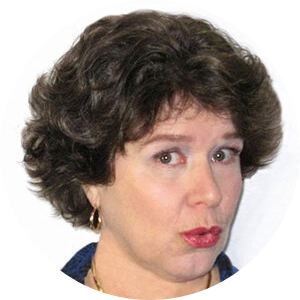
Anna Castle describes herself as “a writer of crime fiction.” To date, she has written seven novels in the Francis Bacon Mystery Series, four Professor and Mrs. Moriarty Mysteries, and two Lost Hat, Texas Mysteries. The biography on her author website discloses that she holds “three degrees: a BA in the Classics (majoring in the Iliad); a MS in Computer Science (good for making money); and a PhD in Linguistics (the natural aptitude thing).” She is “a Texan, a tree-hugger, a bookworm, a dog person, a Trekkie, a history buff, a knitter, and a gardener.”
For more reading
To read my review of the first book in Anna Castle’s Francis Bacon Mystery Series, see Murder by Misrule (A lawyer is murdered in the Elizabethan Age).
I’ve also reviewed three other mystery novels set in the Elizabethan Age:
- A Prisoner in Malta (Christopher Marlowe #1) by Phillip DePoy (A delightful historical mystery novel starring Christopher Marlowe)
- To Shield the Queen (Ursula Blanchard #1) by Fiona Buckley (A worthy murder mystery set in the court of Queen Elizabeth I)
- The Eyes of the Queen (Agents of the Crown #1) by Oliver Clements (They’re trying to assassinate the queen!)
And check out Famous people as detectives in fact and fiction.
You might also enjoy my posts:
- The 10 top espionage novels reviewed on this site
- Top 10 historical mysteries and thrillers reviewed here (plus 100 others
- Top 10 mystery and thriller series
- 20 excellent standalone mysteries and thrillers
And you can always find my most popular reviews, and the most recent ones, plus a guide to this whole site, on the Home Page.


